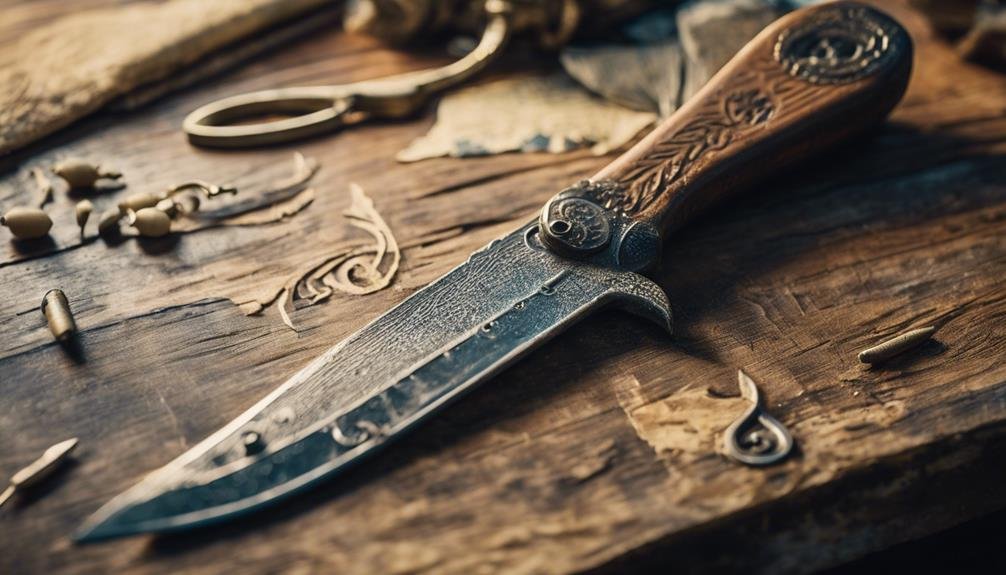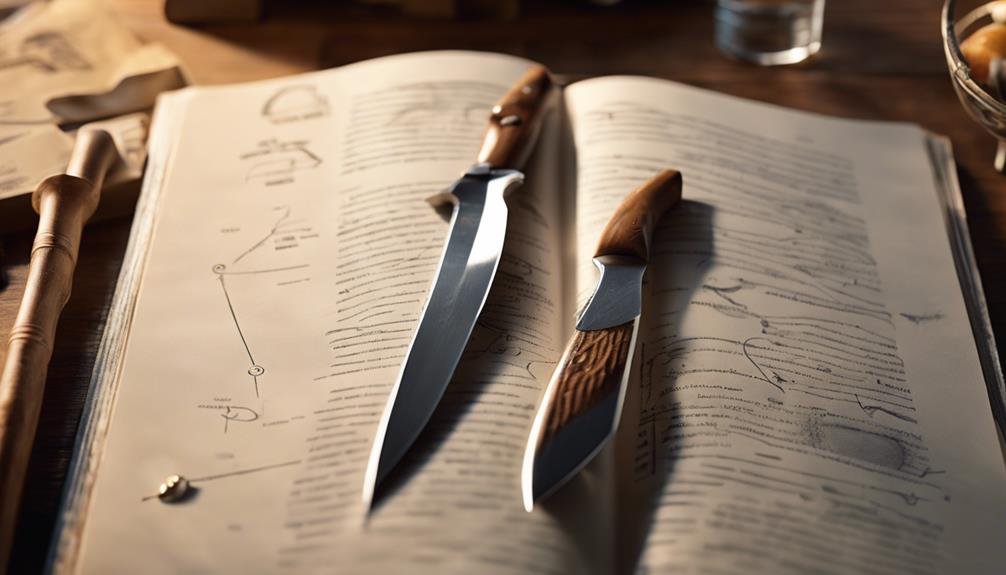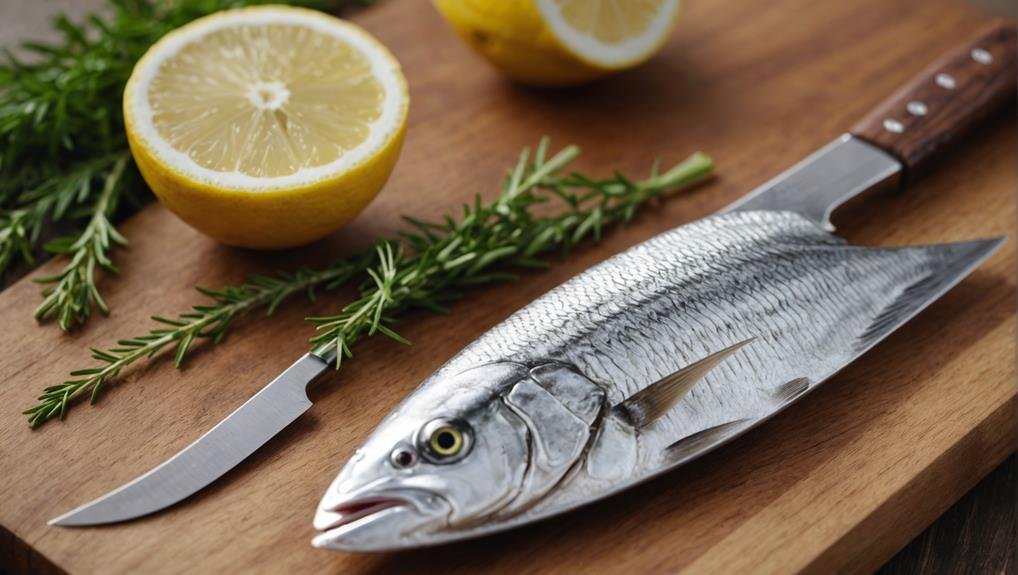When you pick up a fish knife, you hold a tool steeped in tradition and precise craftsmanship. This specialized knife, with its slim, narrow blade and distinctive notch, is designed for the delicate task of filleting fish, ensuring smooth cuts that maintain the integrity of the flesh. Whether preparing a meal at home or working in a professional kitchen, understanding the nuances of a fish knife can elevate your culinary skills. But have you ever wondered about its origins and how it has evolved?
Key Takeaways
- Fish knives have a slim, narrow blade with a pointed tip, typically 8 to 9 inches long.
- Originally luxury items, fish knives became more accessible with electroplating in the 1860s.
- Modern fish knives are made from stainless, silver-plated, and mirror finishes.
- Proper use involves holding the knife firmly and utilizing the notch near the tip for bone separation.
- Fish knives symbolize sophistication and refined dining practices historically and in contemporary settings.
Origin and Evolution

Fish knives originated in the Victorian era and evolved from the 18th-century silver fish slice. Initially, these knives were a luxury item, symbolizing elite status due to their high cost. You’d find them only on the tables of the wealthy, who could afford such luxury. However, the evolution of electroplating in the 1860s made fish knives more accessible to a broader audience. This technological advancement allowed affordable yet elegant versions to be produced, democratizing their use.
Before fish knives became common, the aristocracy managed their fish with two dinner forks. This method, though functional, lacked the finesse that a dedicated tool could provide. As culinary practices evolved, so did the fish knife. By the 19th century, it had taken on a scimitar-like shape, designed to handle fish gracefully and efficiently.
Today, the evolution of the fish knife reflects advancements in materials and design. Modern versions are typically made of stainless steel and are primarily used for filleting fish, lifting skeletons, and removing small bones. This evolution from a symbol of wealth to a practical tool showcases how innovations can transform dining practices over time.
Design and Features
Regarding design and features, a modern fish knife boasts a slim, narrow blade with a pointed tip, perfect for making precise cuts without damaging delicate fish skin.
The blade is straight-edged, allowing you to glide smoothly through fish without tearing. This precision is vital for achieving clean and presentable fillets.
A key feature of the fish knife is its flexibility. The blade is often designed with flexible boning capabilities, meaning it can bend slightly to follow the contours of the fish. This flexibility helps you navigate bones and skin, ensuring each cut is accurate and reduces waste.
Fish knives typically measure 8 to 9 inches long, providing ample reach without compromising control. You’ll find a distinctive notch near the tip to help you effortlessly separate the flesh from the bones. This notch is especially useful for more intricate tasks, such as removing small pin bones.
Fish knives come in various finishes, including stainless steel, silver-plated, and mirror finishes, adding durability and a touch of elegance to your kitchen tools.
These features combined make the fish knife an indispensable tool for any seafood enthusiast.
Materials and Manufacturing

In materials and manufacturing, stainless steel is the most popular choice for crafting durable and efficient fish knives. Stain steel offers excellent resistance to rust and corrosion, making it perfect for use in kitchen environments where moisture is prevalent. Its durability guarantees that your fish knife will maintain its sharpness and structural integrity over time, even with frequent use.
Modern fish knives, typically 8 to 9 inches long, feature a dull blade and a distinctive notch near the tip. This notch is designed to help you efficiently separate bones from the fish flesh. While stainless steel is the most common material, silver-plated steel is also used, providing an elegant touch for more formal settings.
The evolution of the fish knife’s design from a fish server to its current form highlights the importance of functionality and ergonomics. By holding the knife between your thumb and first two fingers, you can easily fillet fish and remove small bones precisely.
Originally symbols of elite status due to their high cost, fish knives became more accessible with the advent of electroplating in the 1860s, democratizing their use.
How to Use
To use a fish knife effectively, hold it between your thumb and first two fingers for a precise grip.
Employ the distinctive notch near the tip to separate bones from fish flesh.
Afterward, focus on cleaning and maintenance to keep your knife in top condition.
Proper Grip Technique
Hold the fish knife firmly between your thumb and first two fingers for optimal control. This grip gives you the precision to carefully lift the skeleton and remove small bones from the fish. With your hand steady and applying gentle pressure, you maintain control while ensuring the knife doesn’t slip. Keeping your hand relaxed, but the firm is essential to avoid fatigue and potential accidents.
The fish knife is designed with a distinctive notch near the tip. Use this notch to separate bones from the fish flesh efficiently. Aligning the notch with the bones allows you to guide the knife smoothly, minimizing damage to the delicate flesh. This technique will enable you to work more efficiently and safely, making the process of filleting or deboning less challenging.
Practicing this proper grip technique will enhance your skill and confidence. Over time, maintaining a steady hand will become second nature, allowing you to handle different types of fish easily.
Effective Cutting Motion
When using a fish knife, start with a smooth, gentle slicing motion to maintain the integrity of the fish flesh. Hold the fish knife between your thumb and first two fingers for precision and control while filleting. This grip guarantees that you can maneuver the knife with ease and accuracy.
Begin using the knife’s pointed tip to lift the skeleton and carefully remove any small bones embedded in the fish.
The distinctive notch near the tip of the fish knife is particularly useful for separating bones from the meat. Work the notch around the bones to extract them without tearing the delicate fillet. This technique is essential for achieving a clean, professional-looking fillet.
If the fish you’re working with is boneless, the fish knife still serves a purpose. Use it to flake pieces of fish onto a fork for easy serving. This method ensures that the fish remains intact and presentable on the plate.
If the fish is already boneless in American-style dining, you might skip the fish knife altogether for a more seamless experience. However, mastering these motions will greatly enhance your filleting skills.
Cleaning and Maintenance
After each use, wash your fish knife with warm, soapy water and dry it thoroughly to prevent rust. This step is essential for maintaining the knife’s performance, especially when using a flexible fillet knife, which requires a sharp, clean blade for precise cuts.
To keep your fish knife in top condition, follow these maintenance tips:
- Sharpen Regularly: Use a sharpening stone or honing steel to maintain the knife’s sharpness. A dull blade can ruin your filleting technique and make the process more dangerous.
- Proper Storage: Store your knife in a knife block or sheath. This protects the blade from damage and prevents accidents.
- Hand Wash Only: Avoid putting your fish knife in the dishwasher. The harsh detergents and heat can damage both the blade and the handle.
- Oil the Blade: Regularly oil the blade to prevent corrosion. This is particularly important for maintaining the longevity of your flexible fillet knife.
Cultural Significance

Fish knives have long been symbolic of social status and refined dining, evolving from symbols of elite Victorian luxury to modern markers of sophistication.
In the Victorian era, owning a set of fish knives was a clear indicator of wealth and status, primarily because they were expensive and often made from high-quality materials like sterling silver. These knives were designed with a flexible blade, allowing for delicate fish handling, which was seen as a luxurious and sophisticated dish.
By the 1860s, the introduction of electroplating made fish knives more affordable, allowing the burgeoning middle class to partake in this once-elite symbol. Possessing a set of these knives became a way for families to showcase their upward mobility and adherence to refined dining practices. The flexible use of fish knives in various social settings further cemented their status.
Throughout the 20th century, fish knives continued to signify upper-class aspirations. Even today, using fish knives at a restaurant can signal sophistication and a keen understanding of dining etiquette. They remain a subtle yet powerful way to convey a sense of elegance and high aspirations in social dining contexts.
Modern Dining Etiquette
In modern dining etiquette, you use a fish knife to fillet and lift bones from your fish, not to cut it. This specialized knife allows you to handle delicate fish flesh with precision. For the best control, hold the fish knife between your thumb and the first two fingers.
Here’s how to properly use fish knives:
- Fillet the Fish: Gently slide the knife under the flesh to separate it from the bones.
- Lift the Bones: Use the knife to carefully remove small bones without damaging the fish.
- Flake the Fish: In American dining style, use the knife to flake boneless fish onto your fork.
- Display Sophistication: Using fish knives in a restaurant can show your high aspirations and refined dining skills.
Historically, owning a set of fish knives symbolized status, indicating you belonged to the middle or upper class. Today, while not everyone uses these knives, they still add a touch of sophistication to your dining experience. Remember, the key is in delicate handling—your goal is to enhance the presentation and enjoyment of your dish without tearing the tender fish.
Further Reading

Several authoritative sources provide in-depth information and fascinating insights into the rich history and modern usage of fish knives.
Historical books on cutlery trace the evolution of the fish knife from its origins as an 18th-century silver fish slice. You’ll discover how electroplating in the 1860s made these utensils more affordable and accessible.
Etiquette guides are another treasure trove of knowledge. They detail the proper handling of a fish knife, noting that it’s traditionally held between the thumb and first two fingers for efficient filleting and bone removal. Modern etiquette books also highlight the knife’s role in contemporary dining settings, ensuring you use it correctly to flake boneless fish onto your fork.
Additionally, references discussing social history reveal how the possession of fish knife sets symbolized middle-class status and upper-class aspirations in the 20th century. These discussions offer a deeper understanding of the cultural significance attached to these specialized utensils.
Don’t overlook academic publications and museum collections, which often feature detailed analyses and exhibits of fish knives. These sources collectively provide a thorough view of how the fish knife has evolved and maintained its place in historical and modern dining etiquette.
Conclusion
By now, you know that a fish knife isn’t just an essential utensil—it’s a vital tool for anyone serious about preparing and enjoying fish. From its specialized design to its rich cultural heritage, the fish knife blends elegance with practicality.
When you use one, you’re not just cooking; you’re honoring a long p but refined dining. Sograb that fish knife and appreciate its craftsmaIt’sory next time you’re filleting fish next time you’re filleting fish.
FAQs
What Is the Point of a Fish Knife?
You use it to follow proper fish etiquette. It’s a pointed tip. When cutting fish, your narrow blade helps you precisely cut fish, remove small bones, and lift the skeleton. It is a nation for fine dining and high aspirations.
What Is a Fish Knife Called?
A fish knife, often called a fillet knife, is essential in Fish Knife Etiquette. It’s designed for precise cuts while preparing fish. You’ll find it ideal for scaling, boning, skinning, and filleting various types of fish.
What Knife to Use to Cut Fish?
You should use a slim, narrow, straight-edge blade with a pointed tip and slight flexibility for cutting fish. This helps in precise filleting techniques, ensuring you don’t tear the fish’s delicate skin or damage its fibers.
What Is the Difference Between a Fish Knife and a Butter Knife?
You’ll notice a butter knife is shorter, wider, and designed for spreading, while a fish knife is longer, more slender, and includes a notch. Their material composition often differs, tailored to their specific uses.

